|
Buddhist Spectrum
Significance of First Council
Premasara Epasinghe
The first ever Buddhist congregation or the first council, was headed
by the senior monk Mahakassapa, whose physical appearance, and the
personality resembled the Blessed one, Gautama Buddha.
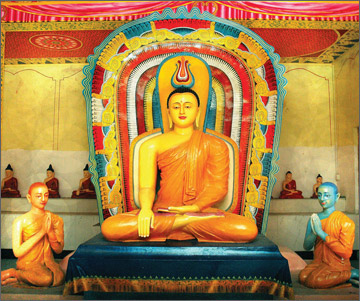 |
|
Arahants
Sariputta and Moggallana in sitting posture around the
Buddha |
After the demise or passing away of the Buddha, the monastic
disciplinary was in the descending order. Therefore, senior monk,
Mahakassapa summoned a congregation, primarily to lay down discipline
rules in the conduct of the Bhikkhus. The word Vinaya is the Sanskrit
term denoting the Rules of Discipline that monks are required to follow.
Throughout the Buddhist Traditions, one of the most important tools for
the formation, continuity and sense of identity of Buddhist Community
has been precepts.
If you analyze further, or broadly, Buddhist precepts are divided
mainly into two categories: the basic precepts common to all traditions,
Theravada or Mahayana; and Bodhisatva precepts, followed by Mahayana
practitioners, both monks and laymen.
Indian Buddhist
The first council was held at Rajagaha. It is the first of its kind
in Indian Buddhist history. This council was convened in the year of
Buddha's Death to establish the Dharma and Vinaya Precepts.
Fearful that the community would dessolve through uncertainty over
Buddhas' teachings, the Sangha decided to hold a council, generally
thought to have occurred in 483 BC to preclude that possibility.
Kin Bimbisara, one of the Buddha's Royal Patrons, donated the site in
his capital at Rajagaha, as the venue for the First Buddhist Council.
Maha Kassapa, a senior monk of the time was appointed President of
the First council and selected 500 Arahat monks participated. Ven Upali
recited all of the Vinaya Pitaka. Ven Ananda, Buddhas' Personal
Assistant, recited all he Buddha Discourses, establishing the Sutta
Pitaka.
In the modern world, Management plays an important role. Discipline
is very important to Bhikkhus and laymen. There is a code of conduct
that should be followed by the sangha or the monks. After the passing
away of the blessed one some monks headed by a certain monk Subaddha,
openly stated that "Teacher is no more. We can have our own way."
Disciplinary standard
There was a deterioration in the conduct of vinaya and this first
council held under the patronage of Mahakassapa and Arahat Ananda helped
to improve the disciplinary standard of the Bhikkhus.
There are two basic vital discourses in Buddhism. They are Ovada
Prathimoksa means to give advice. Through this, you develop self
discipline. It should be remembered that the Buddha delivered a sermon
on Ovada Prathimoksha to the two Chief disciples of the Buddha Sariputta
and Moggallana theras.
Rules and regulations
The other discourse is known as "Ana Desana" which means to order to
follow rules and regulations of discipline.
The deliverance of Vedanaparigga Sutta to Ascetic Diganaka also took
place at Sukarakatalena, close to the Mount Gijjakuta (Vultures Peak).
Sariputra, or Sarputta, was one of the ten major disciples of the
Buddha. He was born in a village to the North of Rajagaha in Magadha,
India. He became a followers of Sanjaya Bellatiputta, along with
Moggallana, the other chief disciple.
Each had one hundred disciples, and all of the disciples became
followers of the Gautama Buddha, after the conversion of their master.
Sariputta was considered as the most foremost in Wisdom among the
Arahant disciples.
The other Aggrasavaka, Moggalana, or Mugalan, one of the major
disciples out of the ten, was known as the foremost in Spiritual Powers.
Both Sariputta and Moggallana were born on the same day. Moggallana
was born to a Brahmena family in the suburbs of Rajagraha, in the
kingdom of Magadha. He was a close friend of Sariputra and also a pupil
of Sanjaya Bellattiputta, one of the six famous non Buddhist Teachers.
Later two of them became followers of Buddha, taking Sanjaya's 250
Disciples.
The elevation to the chief Aggrasravaka Position of Sariputta and
Moggallana took place on a Navam Poya Day.
The First Buddhist Council Functionally marks an important event in
the History of Buddhism. It established authority for the group in the
absence of its to charismaha leader, while at the sometime reinforcing
communal solidarity.
Act of great merit
L J C Boange
In commemoration of this momentous event, it will be an act of great
merit for the President Mahinda Rajapaksa to terminate the slaughter of
cattle in this thrice-blessed country, going along with the tradition of
our ancient kings.
This act will have the effect of protecting all people living in Sri
Lanka whether they are Buddhist, Hindus, Muslims or Christians as grave
natural disasters occur due to sinful acts committed across the world,
in addition to the environmental pollution and destruction.
It is stated in the Cula Kamma Vibhanga Sutta of the Majjima Nikaya
that those who engage in the taking of life, have their lifespans
shortened as a consequence of this sinful act, people will also be
reaping some of the bad Kamma. Furthermore in the Brahmana Dhammikka
Sutta of the Sutta Nipata (one of the Authentic Buddhist Texts) it is
stated thus:
(26) Neither with their legs nor with their horns do the cows hurt
anybody, being obedient like lambs and yielding jars of milk. The king,
seizing them by the horns, had them killed by a sword.
(27) Then the gods, the Ancestors, Indra, the titans and the demons
cried out as the sword fell on the cows: "This is unjust".
(28) In ancient days there were only three diseases desire, hunger
and decay: but owing to the killing of animals, these sprang to ninety
eight."
(29) This old injustice has come down. The innocent cows are killed.
The sacrificing priest have fallen from virtue.
(30) Thus, this ancient, mean practice is censured by the wise
whereven such a practice is seen, people blame the sacrificing priest.
(Translation by Ven Hammallawa Saddhatissa Thera)
In Sri Lanka, there is grain, vegetables, fruits, fish and other meat
products and therefore the ban of cattle slaughter is not going to be
fatal to any person.
Those who cannot live without beef have the imported beef freely
available.
Essentials and non essentials are freely imported into the country.
Therefore the Government, as a measure to reduce the incidence of
disease and to ward off natural disasters which freely occur during
these perilous times, should perform this meritorious act of saving the
cattle for the benefit of the people and the rulers living in this
country.
Digging the anthill
Vammika Sutta:
Sachitra Mahendra
Majjhima Nikaya's third division is allocated for suttas with
similes. As Punna Mantaniputta responds to Arahant Sariputta a simile is
one tool for the wise to understand a deep teaching.
The division contains interesting suttas with convincing similes.
Vammika Sutta is one such Sutta, which looks more like a parable. It is
based on a conversation that takes place between a deity and a monk
called Kumara Kassapa.
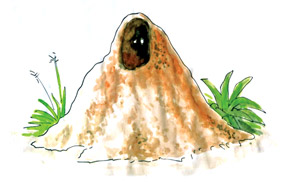 The conversation is interestingly important since the deity is said
to have reached the non-returner status (anagami). Hence it could be
possibly concluded that the divine being came with the intention of
offering spiritual support to the monk. However instead of straight
advice, the deity chooses to offer a riddle so that the monk can work
for a solution. This is similar to the strategy Arahant Mahinda tried
out with King Devanampiyatissa. The conversation is interestingly important since the deity is said
to have reached the non-returner status (anagami). Hence it could be
possibly concluded that the divine being came with the intention of
offering spiritual support to the monk. However instead of straight
advice, the deity chooses to offer a riddle so that the monk can work
for a solution. This is similar to the strategy Arahant Mahinda tried
out with King Devanampiyatissa.
The deity's riddle is woven around an anthill. A brahmin with a tool
must dig the anthill. Digging the anthill, the Brahmin will come across
obstacles, which he should remove with the tool. The first obstacle is a
swollen dead body.
The Brahmin has to remove this with his tool. But his task is not
complete yet. The first obstacle is followed by many others: forked
path, casket, tortoise, slaughterhouse and tendon of flesh. Upon
removing all these obstacles the Brahmin will finally see a snake. He
will have to stop digging further and worship the snake. The deity gives
a cue to Kumara Kassapa: meet the Buddha and ask the solution.
The monk approaches the Buddha for the solution. The Brahmin's tool
is wisdom. To dig means to use right effort. Obstacles symbolize
ignorance. To remove obstacles therefore is to dispel the ignorance one
by one using the wisdom. The anthill is nothing else but the body made
of material form.
The first obstacle or ignorance, swollen dead body, is anger and
reluctance. The second obstacle, forked path, is doubts. The third
obstacle, casket, is five hindrances: sensual interest, aversion, sloth
and torpor, restlessness and doubts. The fifth obstacle, tortoise, is
five aggregates affected by clinging: material form, feeling,
perception, formations and consciousness. The sixth obstacle,
slaughterhouse, is five strands of sensual pleasure. The seventh
obstacle, piece of flesh, is interest for greed. Then the Brahmin sees
the snake, the Bhikkhu who has destroyed desires or ignorance.
Symbols of swollen dead body, piece of flesh and slaughterhouse are
noteworthy, because of their relativity with each other. The lust is
compared to a piece of flesh in Buddhist context. This is not mere
comparison. A swollen dead body is displeasing especially for both eye
and nose. It is not something a common man would love to see or smell.
Whether they like it or not, their own bodies will take the shape of a
swollen dead body.
Anger and reluctance, too, are natural desires. One should work
sincerely to get out of it. Ironically a meditating monk would want to
have a swollen dead body as the subject.
The Pali term for snake is Naga which also means tusker, tree and the
noble being. Certainly it is a snake in this context of anthill, though
the term has other meanings which can relate to the main theme.
Bhikkhu Bodhi, in his co-edited work of The Middle Length Discourses
of the Buddha, quotes commentary to trace relationship between Kumara
Kassapa and the deity. The deity and Kumara Kassapa had been members of
a group of five monks in the period of a previous Buddha, Kassapa. They
had practised meditation together on a mountain top. The deity has
encouraged another fellow monk to see the Gothama Buddha.
This shows that the deity had the ability to see through his fellow
monks' mindsets, and act upon accurate conclusion. Kumara Kassapa is the
son of a Bhikkhuni who went forth without knowing she was pregnant. This
caused controversy till an inquiry revealed her pregnancy happened
before entering the Order.
The sutta doesn't indicate if the monk became enlightened. It merely
states he was delighted to hear the Buddha's words. Perhaps the sutta
serves to be a good subject for both lay and monk to work on reducing
ignorance.
International Buddhist conference
Janath Balasuriya
President Mahinda Rajapaksa visited the Sri Lanka International
Buddhist Academy (SIBA) to inaugurate the International Buddhist
Conference organized by the Indian Council for Cultural Relations
(ICCR). Ministries of External Affairs and Buddhasasana and Religious
Affairs together with the Sri Lanka International Buddhist Academy and
the University of Peradeniya were the partner institutes for the
conference, organized as part of the joint commemoration by India and
Sri Lanka for the 2600th anniversary of the enlightenment by the Buddha.
The inauguration of the conference was also graced by the presence of
Prime Minister D M Jayaratne, External Affairs Minister Prof G L Peiris,
Indian High Commissioner Ashok K Kantha and ICCR Director General Suresh
K Goel. Central Province Governor and a number of senior Cabinet
Ministers, the Attorney General, Deputy Ministers, Parliamentarians,
Provincial Ministers, Members of the Central Provincial Council and
senior Government officials also attended the inauguration ceremony.
Literature
Scholars from Cambodia, Indonesia, India, Nepal, Myanmar, Sri Lanka,
Thailand and Vietnam participated in the Conference. Its theme was
'Cultural Interface between India and Sri Lanka based on Buddhist
History, Art, Literature and Philosophy'.
The papers were presented at the two-day conference, which will be
published in the form of a volume.
Addressing the august gathering, High Commissioner Kantha emphasized
the continuing relevance of the fundamental and universal values and
philosophies that the Buddha propounded.
He underlined that cultural interaction between India and Sri Lanka
had been marked by constant cross fertilization in the spheres of art,
literature and philosophy and the journey of the Holy Tree from India to
Sri Lanka demonstrated this amply. High Commissioner also highlighted
the other activities being undertaken by India to commemorate the
Sambuddhatva Jayanthi.
These include an exposition of the Kapilvastu Relics in Sri Lanka
later this year, setting up of an Indian gallery at the International
Buddhist Museum in Kandy and installation of a specially crafted idol of
the Buddha in Sarnath style from the Gupta period at the entrance of the
International Buddhist Museum complex in Sri Dalada Maligawa.
Pilgrims
He also announced that Indian Railways was planning to launch a
special Buddhist Train Dambadiva Vandana later this year from Chennai
catering to Sri Lankan pilgrims, adding that all these initiatives were
reflective of India's desire to strengthen her cultural and
people-to-people linkages with Sri Lanka, with which India shared deep
historical bonds.
Commitment
Speaking at the inaugural ceremony, ICCR Director General Suresh Goel
emphasized the important role of cultural communication and dialogue in
increasing mutual understanding and highlighted the key role being
played by ICCR in this regard.
He reiterated the commitment of ICCR to strengthening the cultural
relationship between India and Sri Lanka through activities such as
exchange of cultural troupes, exhibitions, distinguished visitors and
scholarships.
External Affairs Minister Prof G. L. Peiris also addressed the
gathering, highlighting the foundation of many modern-day precepts in
Buddhist thought and philosophy.
Mahamevuna Vihara: popular site of worship
Text and pix Priyan de Silva Matara correspondent
The Mahamevuna Maha Viharaya, a Buddhist monastery at Aparekka in
Matara daily draws large crowds. It is estimated that more than 3000
persons visit the Viharaya on Full Moon Poya days for meditation
sessions conducted by 120 resident monks. The monastery is located on a
four hectare land in serene surroundings. One has to turn off at the
Hingurupattala junction on the Kekanadura-Yatiyana road to get there.
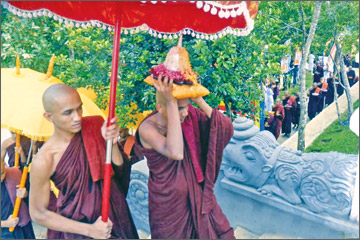 |
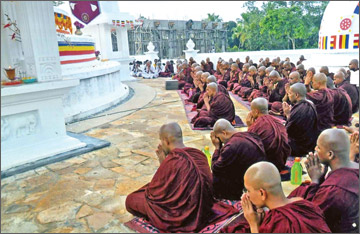 |
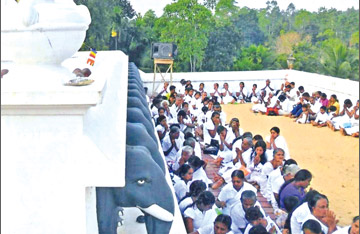 |
| The resident monks bearing offerings
walk in line from their places of meditation for the evening
Buddha pooja |
Buddhist monks at the Mahameuwna
Monastery commence their evening prayer |
Buddhist monks instruct the laymen
and women in rituals |
|



